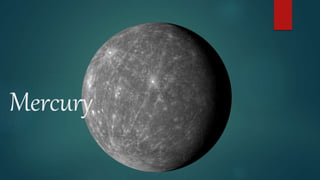Recommended
More Related Content
What's hot (19)
YeSen PPT1 Why Is the Solar Gravitational Force Stronger than the Lunar?

YeSen PPT1 Why Is the Solar Gravitational Force Stronger than the Lunar?
More from sydgrawe
Mercury
- 1. Mercury
- 2. Profile Mass: 330,104,000,000,000 billion kg (.0055 x Earth) Equatorial Diameter: 4,879 Polar Diameter: 4,879 Known moons: none Surface temperature: -173 to 427°C
- 3. Size compared to the Earth
- 4. Fun Facts Closest planet to the sun One year in Mercury is just 88 days Most cratered planet in the Solar System Two spacecraft have visited Mercury
